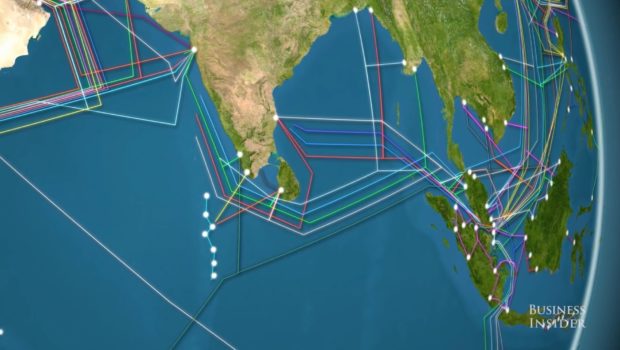Animated Map of Earth’s Undersea Internet Cables
iSpeech
99% of international data is transmitted by wires at the bottom of the ocean called submarine communications cables. In total, they are hundreds of thousands of miles long and can be as deep as Everest Is tall. The cables are installed by special boats called cable-layers. It’s more than a matter of dropping wires with anvils attached to them—the cables must generally be run across flat surfaces of the ocean floor, and care is taken to avoid coral reefs, sunken ships, fish beds, and other ecological habitats and general obstructions. The diameter of a shallow water cable is about the same as a soda can, while deep water cables are much thinner—about the size of a Magic Marker. The size difference is related to simple vulnerability—there’s not much going on 8,000 feet below sea level; consequently, there’s less need for galvanized shielding wire. Cables located at shallow depths are buried beneath the ocean floor using high pressure water jets. Though per-mile prices for installation change depending on total length and destination, running a cable across the ocean invariably costs hundreds of millions of dollars.
Sharks are trying to eat the Internet.
There’s disagreement as to why, exactly, sharks like gnawing on submarine communications cables. Maybe it has something to do with electromagnetic fields. Maybe they’re just curious. Maybe they’re trying to disrupt our communications infrastructure before mounting a land-based assault. (Haha) The point remains that sharks are chewing on the Internet, and sometimes damage it. In response, companies such as Google are shielding their cables in shark-proof wire wrappers.
In 1854, installation began on the first transatlantic telegraph cable, which connected Newfoundland and Ireland. Four years later the first transmission was sent, reading: “Laws, Whitehouse received five minutes signal. Coil signals too weak to relay. Try drive slow and regular. I have put intermediate pulley. Reply by coils.” This is, admittedly, not very inspiring. (“Whitehouse” referred to Wildman Whitehouse, the chief electrician of the Atlantic Telegraph Company, who we’ve discussed previously.) For historical context: During those four years of cable construction, Charles Dickens was still writing novels; Walt Whitman published Leaves of Grass; a small settlement called Dallas was formally incorporated in Texas; and Abraham Lincoln, candidate for the U.S. Senate, gave his “House Divided” speech.
As of 2014, there are 285 communications cables at the bottom of the ocean, and 22 of them are not yet in use. These are called “dark cables.” (Once they’re switched on, they’re said to be “lit.”) Submarine cables have a life expectancy of 25 years, during which time they are considered economically viable from a capacity standpoint. Over the last decade, however, global data consumption has exploded. In 2013, Internet traffic was 5 gigabytes per capita; this number is expected to reach 14 gigabytes per capita by 2018.
View at DailyMotion








Gloss